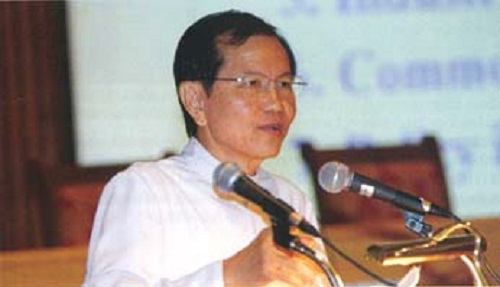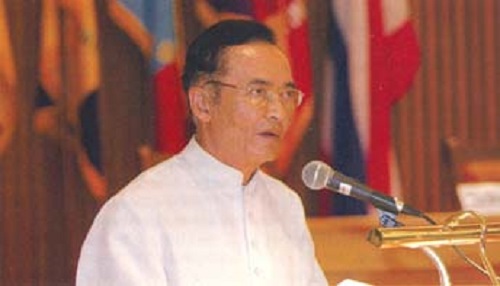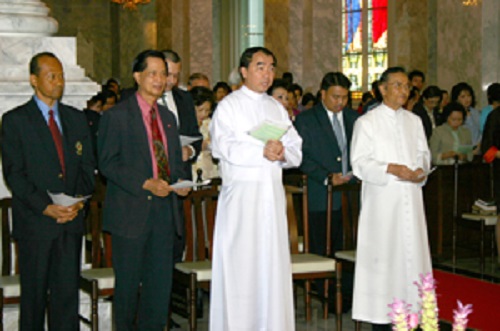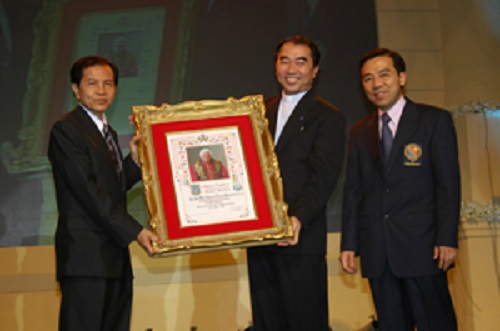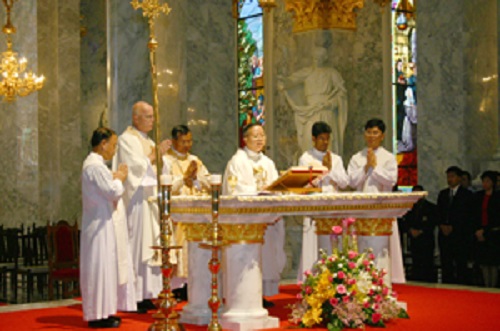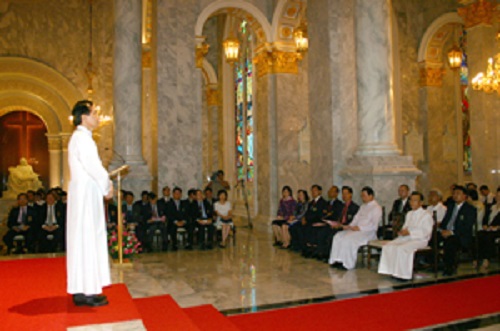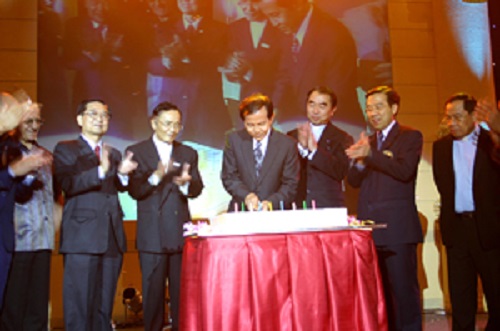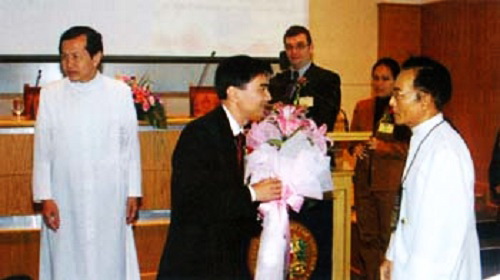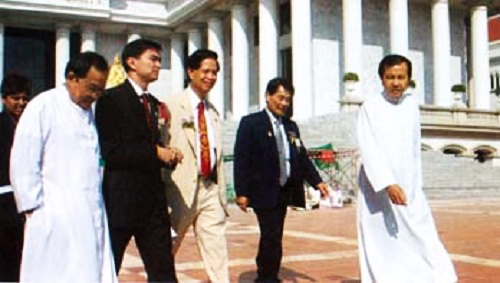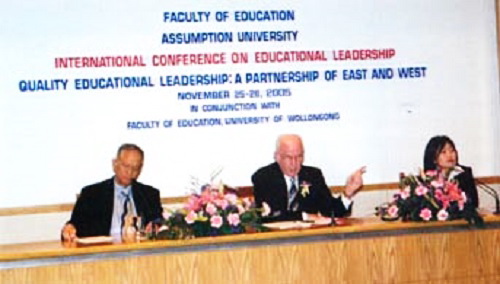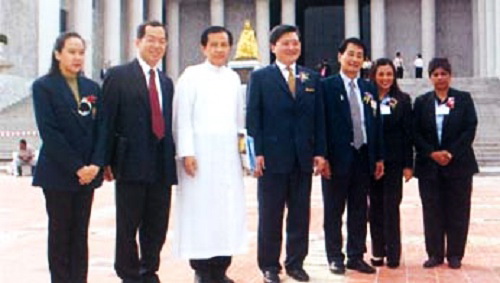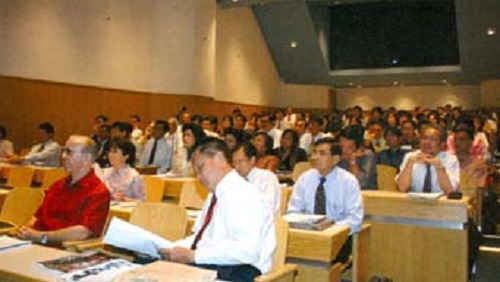ANNUALL FACULTY SEMINAR
May 24-25, 2005
Theme
ICT in Education for Higher Learning
Excerpts from Programme
May 24, 2005
08:30 - 09:50 “The Challenges and Our Future” By Rev. Bro. Bancha Saenghiran, President
10:10 – 11:30 “Compensation Scheme” By Rev. Bro. Prathip M. Komolmas, President Emeritus
12:50 – 14:50 “Using IC Technologies to Improve Education” By Representative from Pearson Education
15:10 – 16:40 “Management in the Era of FTA” By Rev. Bro. Visith Srivichairatana, Vice President for Academic Affairs
May 25, 2005
08:30 – 10:00 “University Facilities Supporting Interactive Learning” By Prof.Dr. Srisakdi Charmonman, Vice President for Information Technology
10:30 – 12:00 “Introduction to Moodles: The Key to Interactive Classroom” By A. Sudsung Yutdhana, Naresuan University
13:00 – 14:30 Faculty Meetin I : Creating Interactive Contents
15:00 – 16:30 Faculty Meeting II: Creating Interactive Contents (Cont.)
President Dr. Bancha Saenghiran giving his discourse on “The Challenges and Our Future”
during the Annual Faculty Seminar held at Bang Na campus on May 24, 2005.
President Emeritus Dr.P.Martin Komolmas speaking on the new “Compensation Scheme”
for faculty and staff at the Bang Na on May 24.
V.P. for Academic Affairs Dr. Visith Srivichairatana speaking on “Organization Management
for Survival in the Free Trade Era” at Faculty Seminar on May 24.
The Challenges and Our Future
“ICT in teaching & learning at the level of higher education”
By Dr. Bancha Saenghiran, President
Work environments of the 21st century place people in an information- rich world. New technologies and new information come to people everyday. People need to deal with the changing environment in order to live well in the world. The traditional division of a lifetime is not appropriate for the current and the future education people.
The Challenges and Our Future.
The current education units still are lecture-dominated and curriculum-dominated. They do not facilitate cultivating the students to learn the learning skill in their future lives.
In the information age, the knowledge and competencies are becoming major components of competition between countries, business companies, and individuals.
-
Before we start discussing about information and communication technology in education, I want to lay some groundwork concerning the challenges we are facing at three levels, namely, global, national, and at the level of higher education.
At the global level, .…
At the national level, .… and ….
At the level of higher education, ….
In 1995, the European Commission catalogues three “factors of upheaval” that are destabilizing society:
-
the impact of information society,
-
the impact of industrialization, and
-
the impact of the scientific and technical world.
In reality…………
What are the forces that drive change in our society and our world?
-
the globalization of commerce and culture,
-
the lifelong educational needs of citizens in a knowledge-driven, and global economy …
-
increasing diversity of our population and the growing needs of under-served communities,
-
the exponential growth of new knowledge and new disciplines,
-
the compressed timescales and nonlinear nature of the transfer of knowledge from campus laboratories into commercial products.
-
And the rapid evolution of information and communication technologies which obliterate conventional constraints of space, time, and monopoly and drive rapid, profound, and unpredictable change in our world.
Changes
The good times before 1997 made everyone rest as if the peaceful world and a prosperous economy would remain forever.
Out over the horizon, these could well be a tsunami of economic, social, technological, and market forces building to heights that could sweeps over higher education before we had a chance to respond.
Like every other social institution, education has undergone many changes over the past few years: “globalization, the emergence of the knowledge economy and lifelong learning have been among them.”
Understanding these changes and some of the forces that have generated them is important to everyone involved in education and human resource development.
The focus on change
It is commonplace nowadays to say we live in changing times. This is most obvious in science and technology – information technology in particular. But we cannot really separate technical from social change and the political, economic and cultural changes that accompany it. New technology brings changes in the nature of work, communication, family, community, and especially lifestyles.
Characteristics of modern societies
-
“modern” period usually refers to the period beginning with the “Enlightenment” in 18th century Europe, through Industrial Revolution and the beginnings of the nation-state until nearly the end of the 20th century.
-
Societies were characterized by order, stability, a belief in sciences and progress, shared values and cultural styles, and so on.
-
Modern education systems originated in societies based on the application of science and technology.
-
What kinds of developments are replacing the old social order of stability, confidence and progress with a world of risk, illusion and ambiguity and bringing a post modern society into existence.
The new conditions call for replacing education with new and different concepts of learning.
-
Although the structure of education remains, the social conditions we have described as modern are changing beyond recognition. Among the most important changes are:
แหล่งที่มา : ABAC TODAY (Vol. 20 No. 2 April - May, 2005) หน้า 1-2










